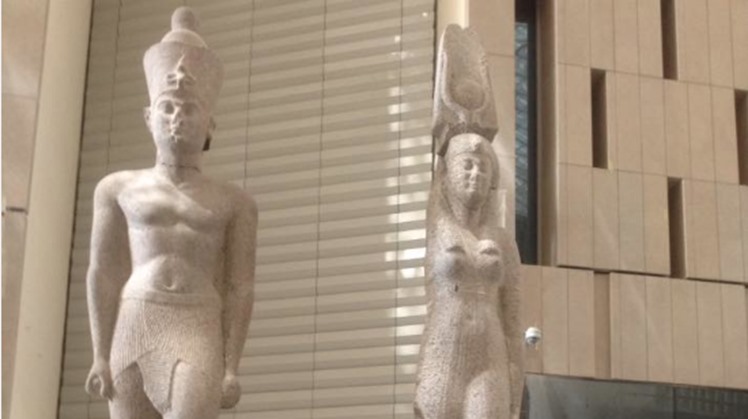Dr. Issa Zidan, Director General of Executive Affairs for Restoration at the Grand Egyptian Museum, said that the two huge royal statues that were among the artifacts displayed in the "Sunken Cities, The Magical World of Egypt" exhibition in the United States of America, have been completed on the Great Stairs, so that they are included in the show scenario of the Egyptian Museum. Great.
These two colossal statues were found underwater in the Gulf of Abu Qir, 6.5 km off the coast of Alexandria, and although there are no inscriptions on the statues, it is possible that the king was Ptolemy II Philadelphus (277-270 BC), and he made The statue of the king is made of granite, and at a height of 5 meters, it is a restored royal statue, wearing the double crown, and the traditional posture, with the left foot forward, his hands clenched.
As for the queen statue, it is made of granite, and its height is 4.90 meters, it represents a standing queen, wearing a crown consisting of the sun disk, two feathers and two horns, and she wears a transparent robe, and the left foot is forward, and the queen may be Arsinoe the second, wearing the costume of the goddess Isis.
The two statues were discovered underwater in 2000, by a joint mission of the European Institute of Sunken Archeology with the Ministry of Antiquities, and the two statues have been on a tour of foreign exhibitions in Europe and America since 2016, and they returned to Egypt, and they arrived at the Grand Egyptian Museum, and it is expected that They are displayed in the Great Foyer.
Abu Qir Bay is located about 26 kilometers to the east of the eastern port in the Alexandria Governorate, where the ruins of sunken cities were discovered, such as the city of Heracleion, which is located northeast of Abu Qir Beach, and the ruins of the city of Canopus, including the temple and parts of the statues of Egyptian gods from the Ptolemaic period. And the Roman, and the two cities fell under the mercy of natural disasters, and sank in the depths of the Mediterranean more than a thousand years ago.
And that city bore the name "Thonis-Heracleion", in reference to the idol Hercules, which is the Greek equivalent of the idol "Amon Gerb", whose worship spread in the region, and was considered the city's protective idol, according to the Egyptian Ministry of Tourism and Antiquities website.
The search began in 1996, and it took several years to map the entire site, and this discovery resulted in important information about ancient monuments, according to which Heracleion and Thunis are in fact two names for one city, as Heracleion is attributed to the Greek name, while Thonis is attributed to the name.
 Wed, Aug. 26, 2020
Wed, Aug. 26, 2020